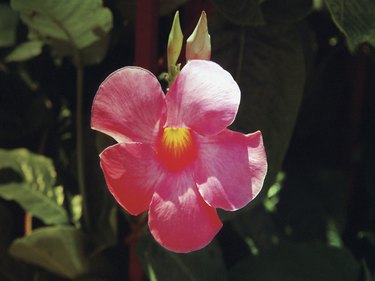
The genus Mandevilla includes many lush, showy, flowering tropical plants. Though generally hardy tropicals, the plants can suffer from a variety of pests and problems, such as spider mites, Corynespora Cassiicola fungus and leaf spot. These problems usually occur during warm, summer months. In the colder months, the plants can also become diseased or ill if not properly wintered. By identifying and properly treating any pests or problems, you can keep your Mandevilla plants healthy throughout the year.
Cercospera Leaf Spot
Video of the Day
Cercospera leaf spot will typically appear on Mandevilla leaves when there is an overabundance of water and moisture in the air or soil. You can distinguish this type of leaf spot from others by examining the spot itself, which should be small (approximately 1/8 inch in diameter) with a light gray center and dark brown or dark purple border around the spot. If your Mandevilla has contracted Cercospera leaf spot, treat it with a systemic, benzimidazole fungicide according to the application instructions.
Video of the Day
Corynespora Cassiicola
Though it occurs less frequently than Cercospera leaf spot, Corynespora cassiicola is a specific type of fungus that can affect an array of tropical plants, including those in the Mandevilla genus. If you notice that your leaves are browning or have brown spots with a yellow halo, then treat your tropical plant with a fungicidal soap or spray.
Spider Mites
Spider mites are pests that can affect a wide variety of plants. They are small insects that can discolor, scotch and even kill a plant. Unlike leaf spot, spider mites often occur when Mandevilles are not watered adequately, and sometimes rinsing infected leaves with water is enough to kill the spider mites. If rinsing the leaves with water does not remove the mites, try a chemical treatment option by applying a miticide to the tropical plant.
Wintering
Because Mandevilla plants are tropical plants, you need to bring them indoors during the winter, especially if you live in an area that has freezing winter temperatures. It may be the case that your Mandevilla plants are exhibiting signs of winter stress, which can easily be confused with a variety pests or diseases. In the fall, when the temperature begins to drop, bring your plants indoors. Reduce the amount of water that you give to the plant and keep it in a bright, warm location. In the middle of the winter, such as in February, prune back your Mandevilla plants significantly, such as two thirds of the entire plant. This will stimulate new, healthy growth for the following season.
- Sunset Plant Finder: Mandevilla splendens
- University of Arkansas Extension: Tropicals - Mandevilla
- North Dakota State University Extension; Cercospora Leafspot of Sugarbeet; H. A. Lamey et. al.; January 1996
- U.S. National Library of Medicine; Host Specialization and Phylogenetic Diversity of Corynespora cassiicola; LJ Dixon et. al.; September, 2009
- Colorado State University Extension; Spider Mites; W.S. Cranshaw and D.C. Sclar; November 2006
- Lake Area Nursery: Diseases of Mandevilla